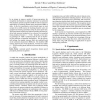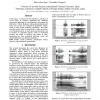92
Voted
INTERSPEECH
2010
14 years 7 months ago
2010
The Lombard effect refers to the speech changes due to the immersion of the speaker in a noisy environment. Among these changes, studies have already reported acoustic modificatio...
85
Voted
INTERSPEECH
2010
14 years 7 months ago
2010
This paper presents an improved wavelet-based dereverberation method for automatic speech recognition (ASR). Dereverberation is based on filtering reverberant wavelet coefficients...
104
click to vote
INTERSPEECH
2010
14 years 7 months ago
2010
Log-linear models have recently been used in acoustic modeling for speech recognition systems. This has been motivated by competitive results compared to systems based on Gaussian...
99
Voted
INTERSPEECH
2010
14 years 7 months ago
2010
Dynamic modeling of spoken dialogue seeks to capture how interlocutors change their speech over the course of a conversation. Much work has focused on how speakers adapt or entrai...
116
Voted
INTERSPEECH
2010
14 years 7 months ago
2010
In an attempt to improve models of human perception, the recognition of phonemes in nonsense utterances was predicted with automatic speech recognition (ASR) in order to analyze i...
81
Voted
INTERSPEECH
2010
14 years 7 months ago
2010
Speech can be divided into discourse genres based on the contextual environment it occurs in (e.g. political speech, sport commentary speech, etc.). The present study investigated...
74
Voted
INTERSPEECH
2010
14 years 7 months ago
2010
Neural network language models (NNLM) have become an increasingly popular choice for large vocabulary continuous speech recognition (LVCSR) tasks, due to their inherent generalisa...
71
Voted
INTERSPEECH
2010
14 years 7 months ago
2010
We present a system for quickly and cheaply building transcribed speech corpora containing utterances from many speakers in a variety of acoustic conditions. The system consists o...
102
Voted
INTERSPEECH
2010
14 years 7 months ago
2010
In this paper, we demonstrate the trichotomic realization of voiced velars in Japanese, challenging the traditional plosive/nasal dichotomy of velar allophones, and examine the di...
118
click to vote
INTERSPEECH
2010
14 years 7 months ago
2010
Using GMM-supervectors as the input to SVM classifiers (namely, GMM-SVM) is one of the promising approaches to text-independent speaker verification. However, one unaddressed issu...


